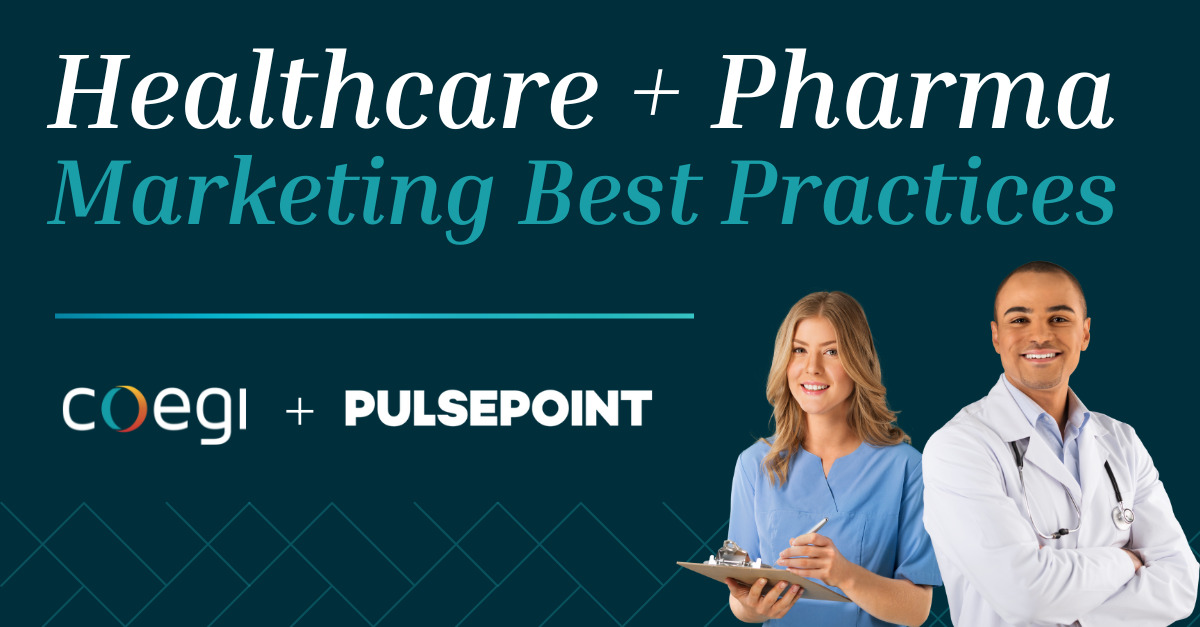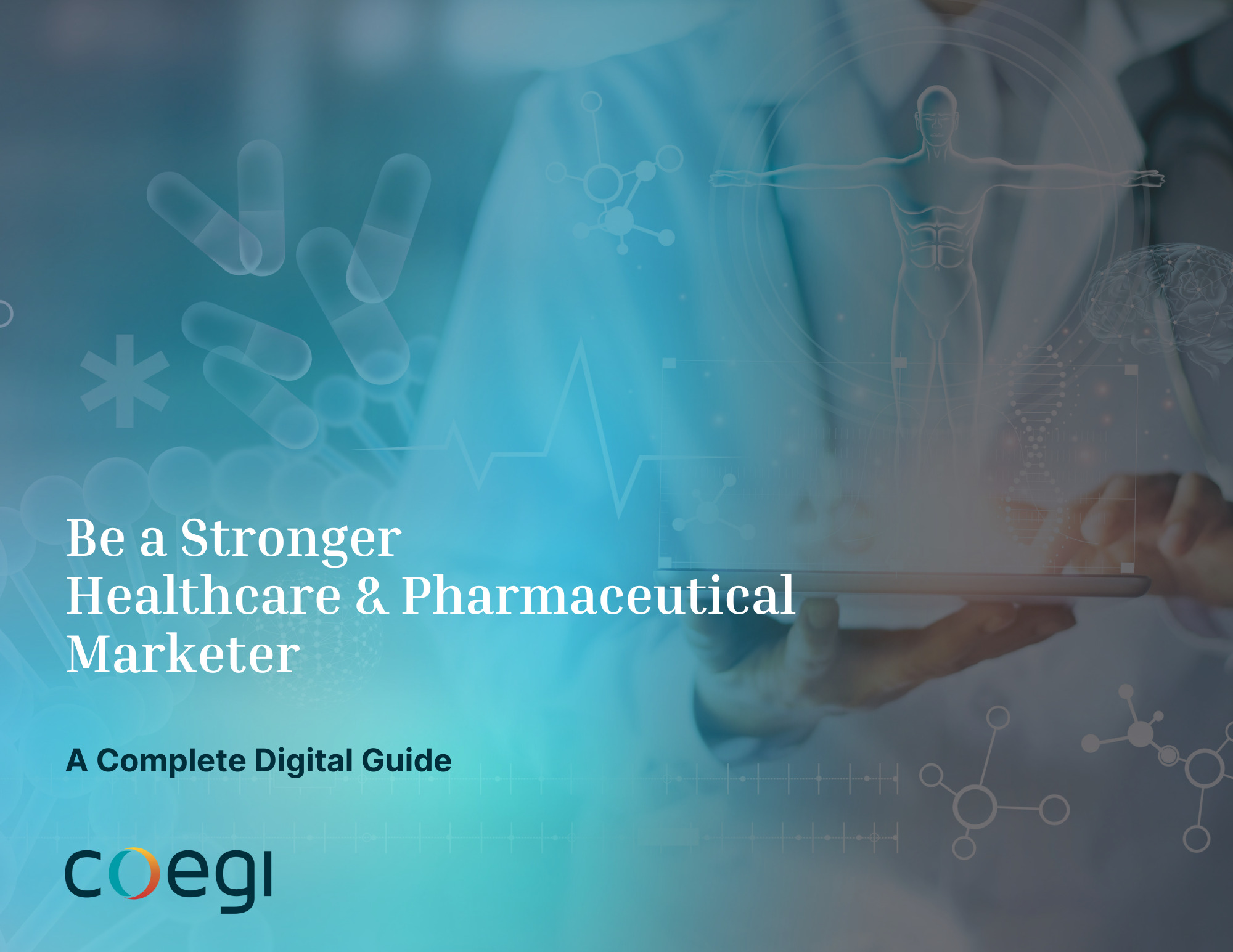Building business solutions for regulated industries is complex. At Coegi, we fearlessly take on clients across many regulated industries, and are well-known for expertise in healthcare and pharmaceutical marketing. Clients come to us regularly to build their knowledge in the space.
This Q&A blog shares our learnings over the years. Coegi’s subject matter expert, Account Strategy Director Colin Duft, and our technology partner PulsePoint’s Head of Strategic Accounts, Malcolm Halle, answer questions regarding healthcare and pharmaceutical digital marketing best practices.

Q: What should healthcare and pharma marketers do to ensure they are being compliant in their digital advertising?
A: PulsePoint – The foundation of all digital advertising is the data behind it. While data sounds like something objective, in reality not all data is created equal. Do the homework and look under the hood to understand the data informing campaigns. From a compliance perspective, two things are crucial:
1) Consent: guarantee healthcare audiences reached provide the brand permission to market to them
2) Deterministic data: the patient or physician information so marketers know they’re actually reaching person who consented to marketing
Building on this, it’s also important to consider the data in totality. The goal is to aggregate enough pieces of data about an individual compliantly to create a complete picture. Then you can meet the patient’s needs accurately. However, this process needs to happen in a privacy-preserving way. Lastly, the freshness of data will affect its usefulness and accuracy.
A: Coegi – Similar to other verticals, it’s important to keep a pulse on the regulatory committee guidelines. Compliance isn’t a black and white map. HIPAA allows room for multiple interpretations, so committees such as the NAI help provide greater clarity. Additionally, it’s important to always be transparent with the client. If something feels off, have a conversation to explain your compliance recommendation and hear their point of view.
Q: The ecosystem of healthcare provider (HCP) marketing is shifting, with the acceleration toward digital. What are the latest trends in healthcare and pharmaceutical marketing for targeting HCPs?
A: Coegi – No matter the strategy, measurement should always be the nucleus of a campaign. Companies like IQVIA and Veeva-Crossix provide marketing measurement products that tell a story and tie back success to a Rx. Use these solutions to complement and build on the brand’s sales team as they start to enter the doctors’ offices once again.
A: PulsePoint – As digital becomes the dominant vehicle to reach HCPs, marketing to them doesn’t need to be restricted to office hours. Instead, understand and seamlessly align with HCPs’ shifting mindset as they go through their day. We can reach them with unique messaging during white coat moments as well as blue jeans moments. We see on our platform that HCPs are visiting work-related websites around the clock. But, we can also coordinate these marketing campaigns on other channels such as Hulu after dinner or on Spotify during a workout. These personalized touchpoints provide a more human experience.
Building on Colin’s point, PulsePoint offers an HCP measurement solution called HCP365. It enables healthcare companies to understand HCP brand actions across digital channels, including website, search and media, at the individual NPI level, in real time. This means brands can now know, with a very high level of certainty, that Dr. Susan interacted with a brand ad, or Dr. Patrick visited the web site. This kind of individual level analytics allows brands to understand, and therefore optimize, media performance with their specific target HCPs.
Q: What outdated advertising strategies do healthcare and pharmaceutical marketers need to leave behind?
A: Coegi – On the healthcare provider side, marketers need to come to terms with the fact that doctors don’t just read medical journals all day. HCPs are people too. Even with a smaller audience, you can hyper target the doctor and scale simultaneously. For consumer campaigns, patients also don’t just read endemic articles on a particular condition all day. Use media to reach them throughout their day across various touchpoints.
A: PulsePoint – Marketers definitely need to break their ties with old school geographic and demographic targeting. This is especially problematic with connected TV. More than half of all CTV buyers in healthcare still use geo/demo targeting. They’re reaching broad audiences with significant waste. CTV offers so many more targeting capabilities, for example, targeting specific HCPs based on clinical behavior or targeting likely patients who have recently researched specific condition content. Take advantage of these capabilities. It may slightly drive up costs, but will significantly improve impact and ROI.
From the patient perspective, we know advertising and content marketing works to drive consumers’ health decisions. But it’s not a simple ‘if X, then Y’ journey. All consumers start their journey at different points, so they react to different messages in different ways. Yet we serve them all the same content and expect to see the same performance. Instead, use predictive analytics and machine learning to identify patterns and recommend marketing actions based on the customer’s profile and previous behaviors. This will maximize downstream results.
Q: Building on this topic, how can marketers reach patients with sensitive health conditions?
A: PulsePoint – The most direct, privacy-safe and effective way to reach people living with sensitive conditions is with contextual media. But don’t think of contextual media from five plus years ago. Contextual is now quite sophisticated. We can serve ads alongside relevant content, of course. When setting up contextual campaigns, it’s also important to understand co-morbidities and correlating factors associated with each condition, and use these to extend reach.
A: Coegi – If a particular health condition is sensitive, there are two primary considerations:
1) How did we collect this targeting data? and
2) if ISI is needed, can it work within the experience I’m trying to deliver an ad within?
Marketers can’t just take data and enter into a platform. They need to do their homework on the company, how they’re collecting this data and the targeting pool. With ISI, some channels fall off when it comes to channel planning. Not all forms of media make sense when you have a long ISI.
Q: Lastly, we know it’s important to lead with empathy. How can healthcare and pharma brands keep patients at the center of their marketing strategy?
A: PulsePoint – Empathy is the ability to understand the feelings and perspectives of another. We can use data to uncover customer perspectives in real time. And we can go one step further: to use these insights to drive marketing outreach, also in real time.
A: Coegi – It’s important to lean into research tools, as well as patient panels/boards. These tools allow you to hear and feel for the individual affected by a particular condition. Translate these learnings into insights. They will then allow you to reach the patient/caregiver where they are in their journey in an empathetic way.
Colin’s final word of advice is to not fall into a rhythm of copy and paste strategies. It may be tempting to go that route as the “safe” choice given all the regulations in healthcare and . But, we must be creative and break the mold with out-of-the box thinking to continue delivering the best strategies using these healthcare and pharmaceutical marketing best practices for your brands.
Want to learn more? Check out Coegi’s guide to healthcare and pharma marketing.






